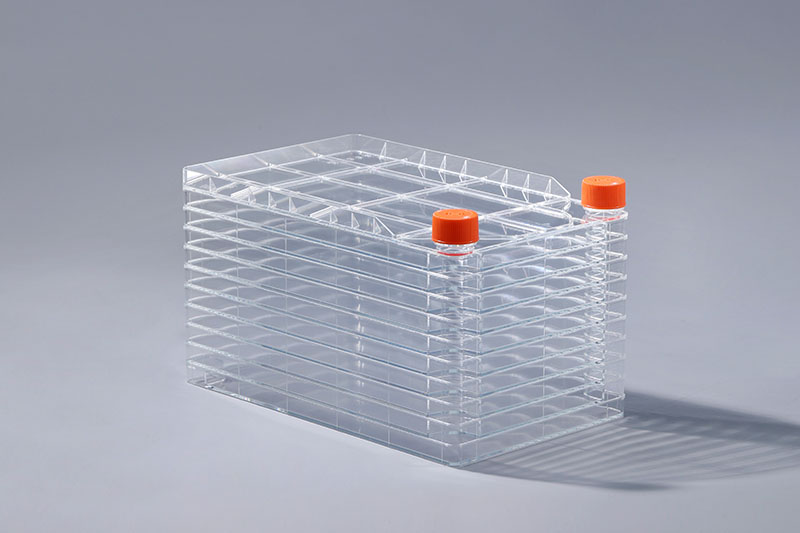Sürekli yenilik ve biyoteknolojinin hızlı gelişimi ile rejeneratif tıp ve hücre tedavisi, patlayıcı bir büyüme yaşadı ve büyük ölçekli hücre kültürü teknolojisi olgunlaşmaya devam etti. Bunların arasında Ek olarak, bir çalkalayıcının kullanılması, numune alınmasına ve farklı parametrelerin belirlenmesine yardımcı olan kütle transferinde rol oynayabilir. Bu nedenle, büyük ölçekli kültür için hücre fabrikalarını kullanırken, kültür verimliliğini artırmak ve hücre kültürünün düzgün ilerlemesini sağlamak için genellikle bir çalkalayıcı kullanılır., büyük ölçekli hücre kültüründe yaygın olarak kullanılan bir sarf malzemesidir ve bu hücre kültürü yöntemi genellikle bir çalkalayıcının yardımını gerektirir. CHO, Vero, MRC-5, 2BS, 293T, L929 ve insan diploid hücrelerini içerir. Bu hücreler esas olarak eritropoietin, monoklonal antikor hazırlama, aşı üretimi ve diğer ürünlerde kullanılır. Hayvan hücrelerinin büyük ölçekli in vitro kültürü, yapay olarak ayarlanmış sıcaklık, nem, pH ve çözünmüş oksijen koşulları altında hücre kültürü kaplarında yüksek yoğunluklu seri üretim gerektirir. yerden tasarruf etme, işgücü girdisini azaltma ve kirlilikten kaçınma özellikleri bilimsel araştırma kurumları ve ilaç şirketleri tarafından giderek daha fazla tercih edilmektedir. Genellikle hücre fabrikalarında büyük ölçekli üretim, bir çalkalayıcının yardımını gerektirir. Bunun nedeni, büyük ölçekli kültürde birçok kap katmanının olmasıdır. Bir çalkalayıcı kullanmak, kültür sırasında sıvı besleme, hücre karıştırma ve sindirim ve atık gibi işlemlerin otomasyonunu gerçekleştirebilir. ve yüksek verimlilik, ağır manuel işlemler ve insan faktörlerinin neden olduğu hataları azaltır.
At present, common large-scale cultured animal cells include CHO, Vero, MRC-5, 2BS, 293T, L929 and human diploid cells. These cells are mainly used in erythropoietin, monoclonal antibody preparation, vaccine production and other products. The large-scale culture of animal cells in vitro requires high-density mass production in cell culture containers under the conditions of artificially set temperature, humidity, pH and dissolved oxygen.
Among many large-scale culture methods, cell factories have the characteristics of saving space, reducing labor input, and avoiding pollution, and are gradually favored by scientific research institutions and pharmaceutical companies. Generally, large-scale production in cell factories requires the help of a shaker. This is because there are many layers of containers in large-scale culture. Using a shaker can realize the automation of operations such as liquid feeding, cell mixing, and digestion and effluent during culture. and high efficiency, reducing errors caused by heavy manual operations and human factors.
In addition, the use of a shaker can play a role in mass transfer, which is conducive to the sampling and determination of different parameters. Therefore, when using cell factories for large-scale culture, a shaker is generally used to improve the culture efficiency and ensure the smooth progress of cell culture.
The FAI climbed 5.9 percent year-on-year in the first 11 months of 2018, quickening from the 5.7-percent growth in Jan-Oct, the National Bureau of Statistics (NBS) said Friday in an online statement.
The key indicator of investment, dubbed a major growth driver, hit the bottom in August and has since started to rebound steadily.
In the face of emerging economic challenges home and abroad, China has stepped up efforts to stabilize investment, in particular rolling out measures to motivate private investors and channel funds into infrastructure.
Friday's data showed private investment, accounting for more than 60 percent of the total FAI, expanded by a brisk 8.7 percent.
NBS spokesperson Mao Shengyong said funds into weak economic links registered rapid increases as investment in environmental protection and agriculture jumped 42 percent and 12.5 percent respectively, much faster than the average.
In breakdown, investment in high-tech and equipment manufacturing remained vigorous with 16.1-percent and 11.6-percent increases respectively in the first 11 months. Infrastructure investment gained 3.7 percent, staying flat. Investment in property development rose 9.7 percent, also unchanged.
 English
English



















































